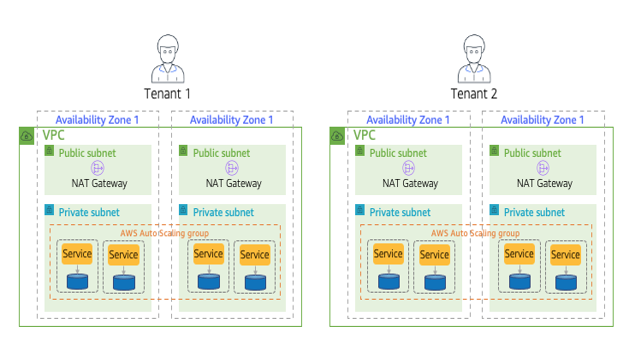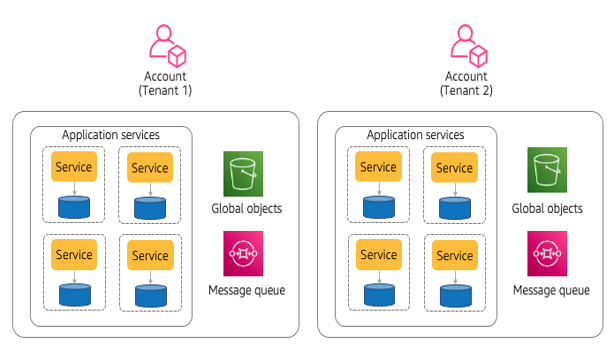The VPC-Per-Tenant Model
The account-per-tenant model relies on a pretty coarse-grained boundary. Let’s shift our focus to constructs that realize a full stack silo within the scope of a single account. This will allow us to overcome some of the challenges of creating accounts for individual tenants. The model we’ll look at now, the Virtual Private Cloud (VPC)-Per-Tenant Model, is one that relies more on networking constructs to house the infrastructure that belongs to each of our siloed tenants.
Within most cloud environments you’re given access to a fairly rich collection of virtualized networking constructs that can be used to construct, control, and secure the footprint of your application environments. These networking constructs provide natural mechanisms for implementing a full stack siloed implementation. The very nature of networks and their ability to describe and control access to their resources provides SaaS builders with a powerful collection of tools that can be used to silo tenant resources.
Let’s look at an example of how a sample networking construct can be used to realize a full stack silo model. Figure 3-6 provides a look at a sample network environment that uses Amazon’s VPC to silo tenant environments.

Figure 3-6. The VPC-per-tenant full stack silo model
At first glance, there appears to be a fair amount of moving parts in this diagram. While it’s a tad busy, I wanted to bring in enough of the networking infrastructure to give you a better sense of the elements that are part of this model.
You’ll notice that, at the top of this image, we have two tenants. These tenants are accessing siloed application services that are running in separate VPCs. The VPC is the green box that is at the outer edge of our tenant environments. I also wanted to illustrate the high availability footprint of our VPC by having it include two separate availability zones (AZs). We won’t get into AZs, but just know that AZs represent distinct locations within an AWS Region that are engineered to be isolated from failures in other AZs. We also have separate subnets here to separate the public and private subnets of our solution. Finally, you’ll see the application services of our solution deployed into private subnets of our two AZs. These are surrounded by what AWS labels as an Auto Scaling Group, which allows our services to dynamically scale based on tenant load.
I’ve included all these network details to highlight the idea that we’re running our tenants in the network siloes that offer each of our tenants a very isolated and resilient networking environment that leans on all the virtualized networking goodness that comes with building and deploying your solution in a VPC-pert-tenant siloed model.
While this model may seem less rigid than the account-per-tenant model, it actually provides you with a solid set of constructs for preventing any cross-tenant access. You can imagine how, as part of their very nature, these networking tools allow you to create very carefully controlled ingress and egress for your tenant environments. We won’t get into the specifics, but the list of access and flow control mechanisms that are available here is extensive. More details can be found here.
Another model that shows up here, occasionally, is the subnet-per-tenant model. While I rarely see this model, there are some instances where teams will put each tenant silo in a given subnet. This, of course, can also become unwieldy and difficult to manage as you scale.
Onboarding Automation
With the account-per-tenant model, I dug into some of the challenges that it could create as part of automating your onboarding experience. With the VPC-per-tenant model, the onboarding experience changes some. The good news here is that, since you’re not provisioning individual accounts, you won’t run into the same account limits automation issues. Instead, the assumption is that the single account that is running our VPCs will be sized to handle the addition of new tenants. This may still require some specialized processes, but they can be applied outside the scope of onboarding.
In the VPC-per-tenant model, our focus is more on provisioning your VPC constructs and deploying your application services. That will likely still be a heavy process, but most of what you need to create and configure can be achieved through a fully automated process.
Scaling Considerations
As with accounts, VPCs also face some scaling considerations. Just as there are limits on the number of accounts you can have, there can also be limits on the number of VPCs that you can have. The management and operation of VPCs can also get complicated as you begin to scale this model. Having tenant infrastructure sprawling across hundreds of VPCs may impact the agility and efficiency of your SaaS experience. So, while VPC has some upsides, you’ll want to think about how many tenants you’ll be supporting and how/if the VPC-per-tenant model is practical for your environment.

